Makerspace
The Makerspace is a collaborative workshop area open to students, faculty and staff. The Makerspace is divided into separate areas for wood-working, metalworking, hand fabrication on plastics and workstations for clay and plaster of paris. The facility is equipped with a hi-tech digital manufacturing laboratory and an electronics workbench. The Makerspace team trains students in design and craft skills and empowers them with the ability to convert ideas into reality.
Makerspace was established to provide students with a facility where ideas can be converted into real products and artefacts. Students can make the following explorations in the Makerspace area:
- Proof of concept prototypes
- Experimental models
- Art and fun articles
- Exploration of materials outcomes
- Full working models
- Programmable and intelligent IoT enabled devices
Users of the Makerspace can work on wood, plastics and other materials like plaster, clay and to a limited extent on metals. The digital manufacturing capability includes 3d printing, laser cutting and etching, as well as a full 8’x4′ CNC routing. These and the electronics workbench equipped with a full set of Arduino boards and supported accessories and daughter boards with sensors and actuators make it possible to invent, create and tinker.
Projects
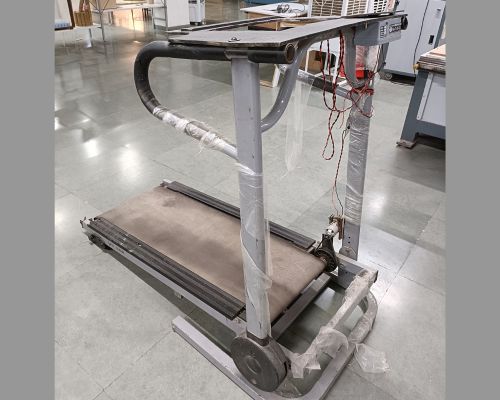
Walk-station
Walk-station
Design student Malav Parekh created the ‘Walk-station,’ integrating a treadmill and work desk to promote fitness and generate electricity. This innovation addresses the challenges of busy professionals with desk jobs, offering a convenient solution to work and exercise simultaneously. The product incorporates a dynamo that converts mechanical energy from walking into electrical energy, reducing power consumption. It encourages a healthier lifestyle and minimizes environmental impact.
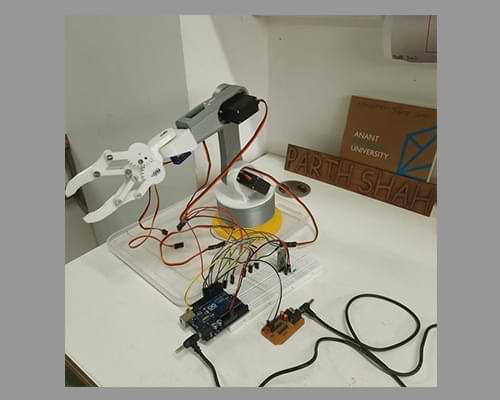
3D Printed Robotic Arm
3D Printed Robotic Arm
The 3D printed Robotic Arm Demonstrator is a model made for the benefit of students to understand the basic working of a robotic arm. The model was 3D printed on the Makerspace 3D printer, while the servomotors (basic power and intelligence) were provided from the Electronics Workbench. The robot operates on Arduino Uno boards, that sends motion commands to the arms’ servo motors. The model is made using Poly Lactic Acid and ABS filaments, that makes it sturdy and gives it strength. This configuration is also called the Articulated Arm 5 axis Robot.
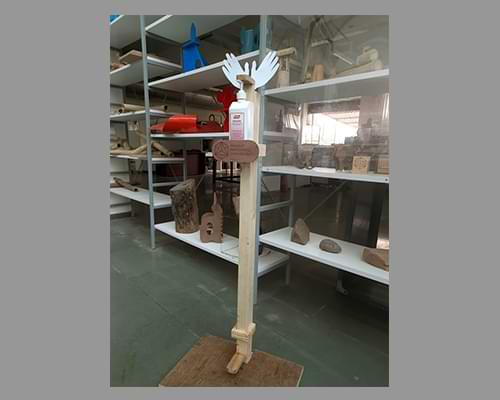
Wooden foot-operable
sanitizer dispenser
Wooden foot-operable
sanitizer dispenser
The purpose of this invention is to control the spread of coronavirus from an infected person to others while using the same sanitizer bottle.
With this device, the sanitizer could be used without touching the bottle with hands. By pressing the pedal with a foot, the bottle would dispense the liquid.
This device is mainly designed for use in public spaces like hospitals and companies and universities where a large number of people assemble.
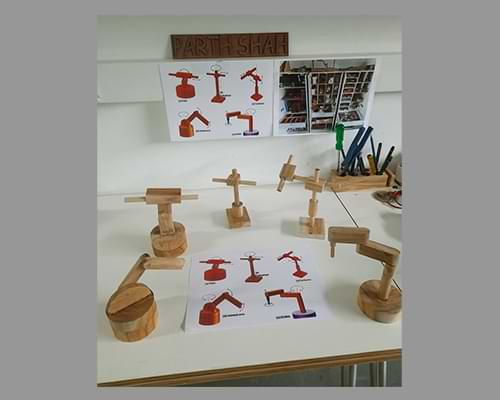
Robot Configurations for
Design Students
Robot Configurations for
Design Students
There are five main types of industrial robots: Cartesian, SCARA, cylindrical, Polar and Jointed arm. Each of these types offers a different joint configuration. The joints in the arm are referred to as axes.
Typical industrial robots are articulated and feature six axes of motion (6 degrees of freedom). This design allows for maximum flexibility. Six-axis robots are ideal for:
- Arc Welding
- Spot Welding
- Material Handling
- Machine Tending
- Other Applications
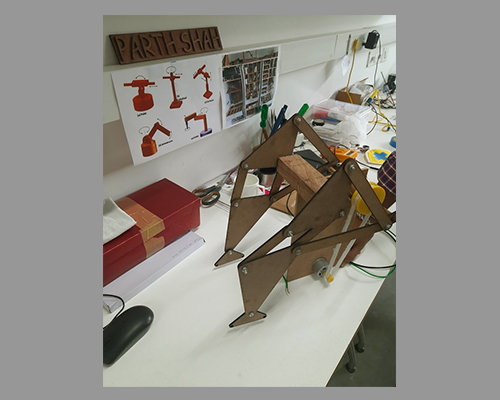
Bi-Ped Robot
Bi-Ped Robot
Bipedalism is a form of terrestrial locomotion where an organism moves by means of its two rear limbs or legs. An animal or machine that usually moves in a bipedal manner is known as a biped meaning “two feet” (from the Latin bis for “double” and pes for “foot”). Types of bipedal movement include walking, running, or hopping. This model is made using components such as wood, DC motor and pulley system. When the motor is energised, the wooden biped moves in a motion similar to a biped. The linkages are called the ‘Theo Jansen Walking Mechanism’, which is a popular biped mechanism.
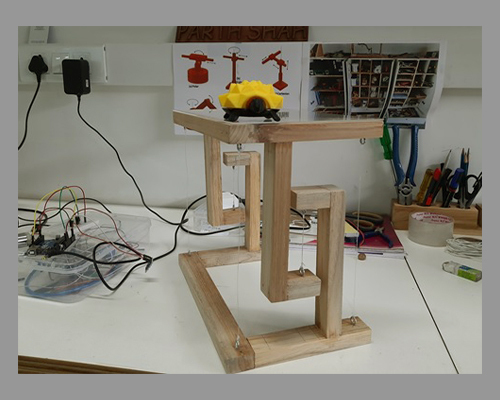
Levitating 'Tensor' table
Levitating 'Tensor' table
Levitation (from Latin levitas “lightness”)is the process by which an object is held aloft, without mechanical support, in a stable position. Levitation is achieved by providing an upward force that counteracts the pull of gravity (in relation to gravity on earth), plus a smaller stabilising force that pushes the object toward a home position whenever it is a small distance away from that home position. The force can be a fundamental force such as magnetic or electrostatic, or it can be a reactive force such as optical, buoyant, aerodynamic, or hydrodynamic. This table is one of the numerous explorations using Tensor-structures.
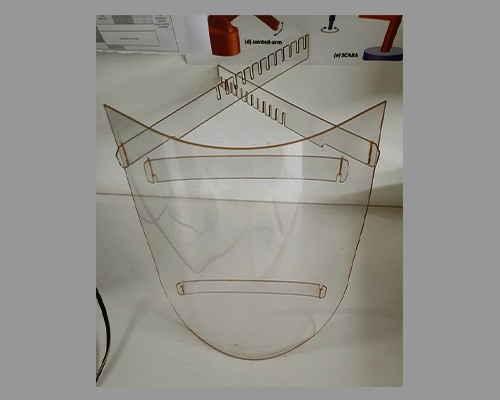
Visor Mask
Visor Mask
A visor is a protective device, useful for masking from harmful chemicals or bacteria/virus. It has gained popularity in Coronavirus pandemic and is often used by health-workers to protect themselves from COVID-19 patients. The Makerspace team manufactured several visors from polycarbonate sheets and provided them to the Ahmedabad police force and local hospitals as the first layer of protection from the virus.

Self Balancing One-wheel
Drive Concept
Self Balancing One-wheel
Drive Concept
Onewheel is a self-balancing single wheel electric board-sport, recreational personal transporter, often described as an electric skateboard. Unlike the electric unicycle, the riders feet (and body) are typically pointed at a perpendicular angle to the wheel and direction of travel.

Staircase Robot
Staircase Robot
Staircase climbing robot are often used to conduct scientific analysis in dangerous terrains. Many mobility designs that are used currently are complex, making use of many wheels or legs. An eight-wheeled rover is capable of traversing rough terrain using an efficient high degree of the mobility suspension system. This prototype is designed to overcome inclines and enables people to move over terrains standing on the robot’s platform. The prototype is made using a sturdy metal frame base, metal lead arms and rubber tracks for traction that is driven by a 24V DC Gear motor.

3D Printer Design for
Covid-19 kitchen,
Mobile Stand, Charging Stand
3D Printer Design for
Covid-19 kitchen,
Mobile Stand, Charging Stand
3D printing, or additive manufacturing, is used for the making of a three-dimensional object from a CAD model or a digital 3D model. The term “3D printing” can refer to a variety of processes in which material is deposited, joined or solidified under computer control to create a three-dimensional object, with the material being added together (such as liquid molecules or powder grains being fused together), typically layer by layer.
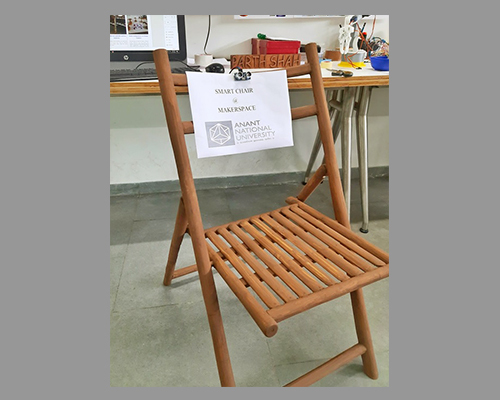
Smart Chair
Smart Chair
The Makerspace team turned a normal chair into a smart chair that can continuously detect sitting posture and send an alarm for wrong postures. Sensors and other interfacing devices are used for automation that can resolve medical problems of the spine.
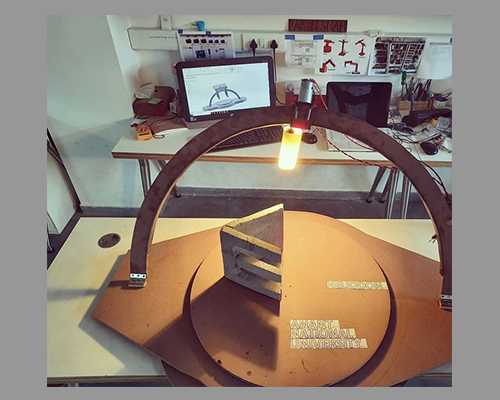
Heliodon
Heliodon
A heliodon (HEE-leo-don) is a device used for adjusting the angle between a flat surface and a beam of light to match the angle between a horizontal plane at a specific latitude and the solar beam. Heliodons are used primarily by architects and students of architecture. By placing a model building on the heliodon’s flat surface and making adjustments to the light/surface angle, the investigator can see how the building would look in the three-dimensional solar beam at various dates and times of the day.
Issue Tracker Application
Issue Tracker Application
The issue tracker records data on machine/materials issued to students and staff. It supports technician and managers to track stock usage in real time.
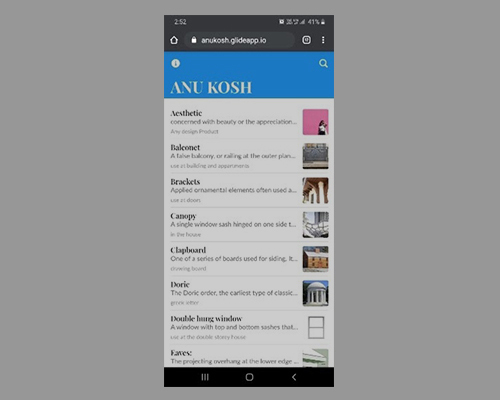
ANUKOSH ( Dictionary for Architecture Students)
ANUKOSH ( Dictionary for Architecture Students)
ANUKOSH application is used for the listing of architecture terminologies in several languages, arranged alphabetically, and includes information on the definition, usage, etymologies, pronunciation, translation, etc.

Smart Bamboo Fountain
Smart Bamboo Fountain
The smart bamboo fountain uses a DC Motor Pump and LCD, where LCD is used to display the text message, to show the temperature and humidity with the help of sensors.
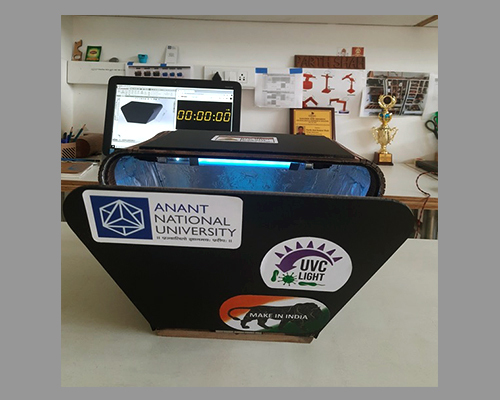
UV Steriliser
UV Steriliser
This steriliser uses short-wavelength ultraviolet (ultraviolet C or UV-C) light to kill or inactivate microorganisms by destroying nucleic acids and disrupting their DNA, leaving them unable to perform vital cellular functions. UVGI is used in a variety of applications, such as food, air, and water purification.
UV-C light is weak at the Earth’s surface since the ozone layer of the atmosphere blocks it. UVGI devices can produce strong UV-C light in circulating air or water systems which creates an inhospitable environment for microorganisms such as bacteria, viruses, mould, and other pathogens. UVGI can be coupled with a filtration system to sanitise air and water.
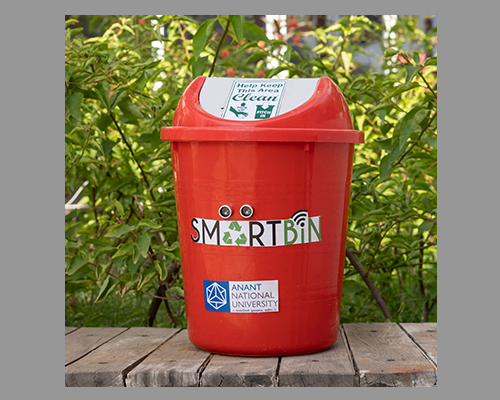
Smart Bin
Smart Bin
‘Smart bin’ is an innovative way to manage garbage systems during COVID-19 pandemic in hospitals, malls, religious and public places and offices. The smart bin opens automatically when the user approaches within its range thus keeping the disposal process contactless and hygienic. Additionally, the bin warns the garbage collectors when it reaches its capacity signalling that it needs to be emptied. This enables the garbage collection systems to function timely and prevent overflowing of garbage. Smart bin serves as a great alternative to the traditional system as it facilitates the cities in keeping areas free of Bio-Waste that could potentially be hazardous and spread infections.
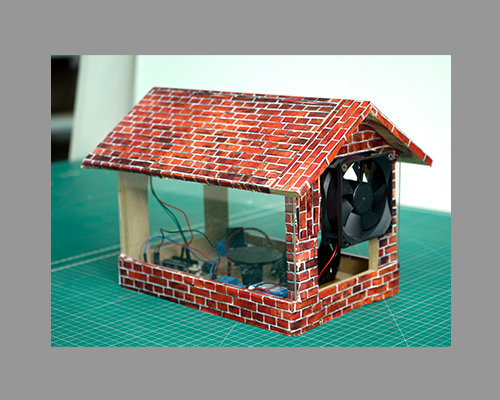
Intelligent Kitchen
Intelligent Kitchen
Intelligent Kitchen, an innovation by faculty member Parth Shah and his team, comes with a robust gas sensor that senses LPG, smoke, alcohol, propane, hydrogen, methane and carbon monoxide concentrations in the air.The sensor is connected with the controller, and via relay, the external chimney and exhaust fan can be switched on automatically. It senses harmful gases and clears them from the space thus, ensuring no damages to the kitchen equipment and prevents the house from catching fire.

Solar-Powered Air Cooling Green Solution
Solar-Powered Air Cooling Green Solution
The Makerspace innovation is a compact, sustainable, solar-powered clay pot air cooler. The tabletop mud air cooler can be easily operated in remote areas, commercial and residential spaces. The innovation, which aims at creating a positive impact on the environment, uses a solar panel to generate electricity and run the computer fan attached to the top of the clay pot. The pot is half-filled with water, with holes created at one of the planes, generating the airflow, which is nearly 10-degree less than the environmental air.
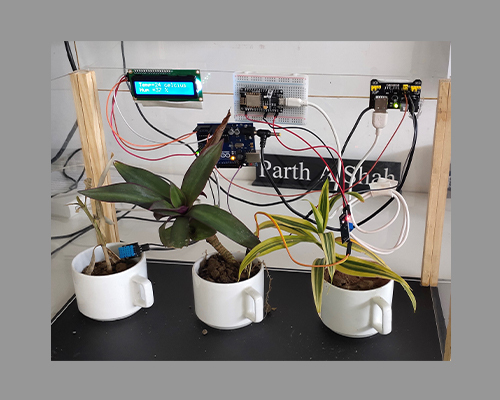
IOT Based Green House for Climate Control
IOT Based Green House for Climate Control
This innovation will enable the user to get the live data of soil moisture content with a graph and show the temperature and humidity level on the LCD screen. Created on Blynk platform, the app will allow users to get readings globally, find the parameters of soil and provide artificial light to help plants grow better. The technological innovation aims at revolutionising organic farming and gardening techniques and can also be used for irrigation purposes.

Smart Assistive Stick for Blind People
Smart Assistive Stick for Blind People
Developed using a foldable stick, the innovation uses a distance sensor that can be programmed using hand movements. The sensor, connected with the controller, filters the data to check for a safe distance and sends the signal to the controller and the buzzer to notify and alert the users about nearby objects. This innovation intends to help blind people continue their daily activities, from walking to visiting family and friends. It aims at making them more independent while being completely safe.

IoT based E-Oximeter
IoT based E-Oximeter
The innovation, E-oximeter, displays the pulse rate (bpmPR) and oxygen level (%Spo2) straight into the doctor’s phone thus, making it easier for them, the nursing staff and the caretakers to monitor the readings from anywhere in real-time with the help of the Internet of things (IoT) technology. The user needs to download the application and access it using a login ID and password to check the readings. The device is compact, rechargeable and is compatible with mobile chargers.
Team
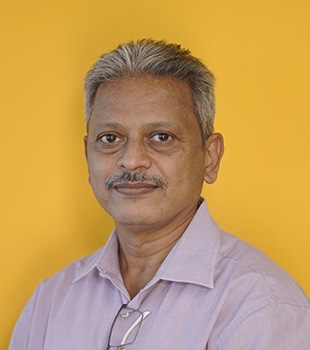
Milind Chitale
Associate Professor, School of Design and Director, Makerspace
MDes, Indian Institute of Technology Bombay

Parth Shah
Assistant Professor, School of Design and Manager, Makerspace
MTech, Nirma University

Nisar Ahmed
Assistant Professor, Makerspace, School of Design
MFA, Cambridge School of Arts, Anglia Ruskin University

Girish Gajjar
Lab Technician, Makerspace, AnantU

Mayank Suthar
Lab Technician, Makerspace, AnantU